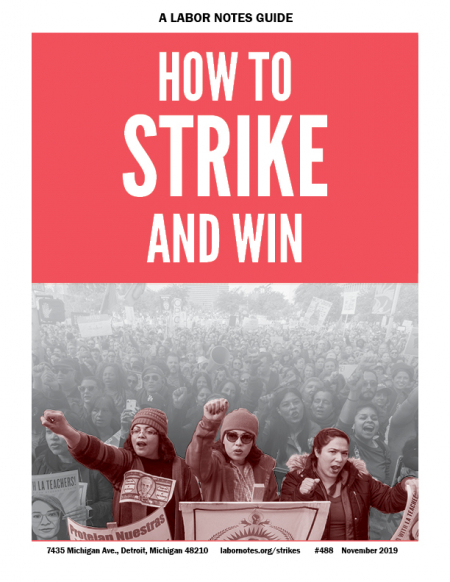Dealing with the Law

If you anticipate a legal battle, budget for it. Photo: Monika Warner.
The law is stacked against strikes, so knowing the law and when and whether to break it is essential.
How to Strike and Win
A Labor Notes Guide
labornotes.org/strikes
The Big Picture
Know Your ABC's
Building Blocks
- Turn Up the Heat
- Organize the Organized
- Democracy: Who Owns the Strike?
- Community: Who Else Owns It?
- How to End a Strike
At a Glance
Most U.S. workers have some law granting them the right to bargain collectively, but not all strikes are protected by the law. And even when a strike is legal, many of the tactics that would make it maximally effective are not.
An essential resource is longtime labor attorney Robert Schwartz’s book No Contract, No Peace: A Legal Guide to Contract Campaigns, Strikes, and Lockouts. Consult an attorney as you make your plans. The Trump Labor Board has been changing many legal interpretations, all for the worse. If you anticipate a legal battle, budget for it.
ONE OPTION: BREAK THE LAW
As the saying goes, “There is no illegal strike, just an unsuccessful one.”
The great postal strike of 1970 was the largest wildcat in U.S. history. No one got fired. After eight days out, postal workers won full collective bargaining rights—though still no right to strike.
West Virginia teachers brought their state government to its knees in 2018. Legally they could have been fined or outright replaced. But they weren’t, because they had widespread public support and because there was no one to replace them. They won.
Don’t be reckless, though. A walkout with no legal protection can also end in disaster—remember the air traffic controllers.
Make a frank assessment of your options, the possible consequences, how united members are, how much risk the group is willing to take, and how much leverage you have. Breaking labor law isn’t a decision for a lone member to take, since the whole union might suffer from the results.
USE THE ULP
WHO'S COVERED?
By default when we talk about labor law, we are talking about the National Labor Relations Act, which covers most private sector workers. It protects some strikes and not others.
Rail and airline workers fall under the Railway Labor Act, which allows strikes only over issues deemed “major” and only after a lengthy negotiation and mediation process. Permanent replacements are allowed.
Farmworkers and domestic workers are excluded from federal labor law for racist historical reasons, so they have neither legal limits nor protections on their right to strike.
Federal workers have limited collective bargaining rights but not the right to strike.
State and local public workers are covered by state laws, which vary. Some states allow strikes, but require certain steps first such as fact-finding, mediation, or a supermajority vote. You will need to build those steps into your campaign timeline. Other states ban strikes, sometimes with serious potential consequences for the union and the strikers. Still other states have no law one way or the other.
If you can, it’s always safer to frame your strike as an unfair labor practice (ULP) strike rather than an economic strike.
That’s because under the National Labor Relations Act (NLRA), economic strikers may legally be permanently replaced. After the strike ends, they have the right be called back only as positions open up.
When a ULP strike ends, workers have an absolute right to their jobs—even if the employer must dismiss scabs it has promised permanent employment. If the employer disregards the law, it can be ordered to reinstate strikers with back pay. Likewise, if the employer illegally locks out ULP strikers, it will be on the hook for back pay.
Some examples of ULPs the employer may commit are surveilling union activities, disciplining union leaders, unilaterally implementing new rules and policies, refusing to supply relevant bargaining information, and prohibiting distribution of union literature.
One way to precipitate ULPs is to carry out a militant on-the-job contract campaign. Employers often respond illegally when workers:
- wear hard-hitting union buttons, T-shirts, and other insignia
- distribute handbills in nonworking areas, such as parking lots, front steps, and lunch rooms
- hold rallies in those areas
- hold informational pickets before and after work
Employers also detest it when the union submits requests for information. Total or partial refusals are ULPs. If it concerns a matter of importance to bargaining, a refusal to furnish information can be a basis for a ULP strike.
Another card the union can play: letting the contract expire while remaining on the job. Without a “management rights” clause in effect, you can demand to bargain over any unilateral changes the employer wants to make in day-to-day matters such as schedules, assignments, supervisory methods, work rules, or safety policies. If the boss refuses to bargain, that’s another ULP.
Employers with knowledgeable lawyers will attempt to settle ULPs before the contract expires. Do not cooperate.

SUPPORT LABOR NOTES
BECOME A MONTHLY DONOR
Give $10 a month or more and get our "Fight the Boss, Build the Union" T-shirt.
Make clear that your strike is a ULP strike from the get-go. At the strike vote, the ballot should ask, “Do you vote yes because of the employer’s unfair labor practices?” Signs, handbills, and interviews should describe the violations.
During their contract campaign in 2019, AT&T workers in Florida built unity by wearing UV protection sleeves that said “I pledge CWA.” Management suspended seven members for wearing the sleeves—a clear anti-union move, since workers were allowed to wear similar sleeves with other designs.
Their local union spotted the ULP and called a walkout. The next day the rest of the bargaining unit, 20,000 workers in nine states, joined the strike over a different ULP, bargaining in bad faith. The strike ended four days later when management began to negotiate in earnest. A day after that, they had a tentative agreement.
RISKY BUSINESS
Because of the power of strikes, Congress and legislatures have hemmed them in with laws to make them less effective. You can strike—but you can’t block scabs. You can strike—but not on your own timetable.
A revived labor movement will have to break the legal chains that bind us, as teachers in West Virginia, Oklahoma, and Arizona showed us in 2018.
At the same time, there’s no denying the risks: arrests, injunctions, suits, large financial judgments, being trusteed by your International. A union that decides to break anti-worker laws
should do so united, and with a plan for the consequences.
Is your leverage great enough to make the law moot? (They can’t fire us all.) Do you have lawyers on hand for the fallout?
Can you make withdrawal of legal charges part of the strike settlement? Will the public put the fear of God into politicians or police chiefs that try to harm the union? Balance the potential risks against the possible gains.
CONSIDER THE LOCKOUT
Provoking a lockout is another way to get some legal protection against permanent replacements, and it has other practical advantages over a strike. (See here.)
If it seems like your employer is determined to provoke a strike, consider surprising him by staying on the job. Getting locked out might be the better option! But to keep morale up, it’s important that members agree on the strategy and understand the advantages. These include collecting unemployment benefits, in most states, and creating a growing tab of back pay that the employer may owe if the walkout is a ULP strike.
INTERMITTENT STRIKES
The NLRA bans a series of short strikes for a common goal. But a union can still call a “practice” or “warning” strike, return to work, see if the employer comes around, and days or weeks later strike for an indefinite period.
A union can also call separate walkouts having distinct origins and demands. For example, a union whose contract has expired could strike against a unilateral change to working conditions, a refusal to provide information, and then a safety hazard. Hold the walkouts quickly after the triggering event, but not too close together.
As long as there is no evidence tying the actions together as part of a planned campaign, workers should have legal protection against employer retaliation.
SECONDARY TARGETS
A division of the same parent corporation can be legally picketed only if it is closely integrated with the struck employer, for instance with centrally controlled labor relations.
This fall 24 newly organized Teamsters in suburban Boston struck for a first contract with the waste collection company Republic Services. The union helped them extend their picket lines to Republic garages as far away as San Jose and Anaheim, California. The extended picket line was especially effective because their fellow Republic Teamsters had the contractual right to refuse to cross the lines—creating one-day sympathy strikes.
On the other hand, most outside businesses, including suppliers and customers, are considered neutrals, and the Labor Board has prohibited picketing and large demonstrations against them. In those cases unions that are following the law must confine themselves to nonconfrontational tactics like leafleting and bannering in a stationary position.
Republic strikers protested Bill Gates, the company’s biggest shareholder, at an event his foundation sponsored. They held banners: “We Pick Up The Trash, Bill Gates Gets The Cash.”
GRIEVANCE STRIKES
When the contract is expired, the union can strike over grievances.
For instance, AT&T workers in Dayton, Ohio, struck for two days in 2015 after a member was sent home for losing a $6 tool. By the end of the second day, management had rescinded the discipline. The strike was a chance for members to flex their muscle during stalled contract talks.
“It opened up the eyes of the management team,” said a local bargainer.
It’s legal, but a grievance strike is usually an economic strike, so the employer could hire permanent replacements. To reduce the risk, grievance strikes should be short—generally one to two days.
The union should also announce shortly after the strike begins the date and time when members will return to work unconditionally, even if the grievance isn’t resolved. Strikers are generally protected against permanent replacement once they have submitted an unconditional offer to return to work. (See here for how Golan’s Moving strikers used this to their advantage.)
Grievance strikes should not be aimed at influencing bargaining—they should be called around immediate grievances or safety issues. And don’t conduct too many grievance strikes, or you could run afoul of the rule against intermittent strikes. Conducting more than two walkouts in a short period risks losing legal protections.Be prepared for the risk of a lockout in response.
“The principal reason for a grievance strike is to test out the members’ strikereadiness,” says Teamsters Local 705 rep Richard de Vries. “This is truly a solidarity-building tool, but it doesn’t happen without taking all the other baby steps that lead up to it.
“Have you had a T-shirt day? Have you had a one-hour practice picket? Unless all those other kinds of activities are also going on, it’s hard to have a successful grievance strike.” (For more on escalating tactics like these, see here.)





